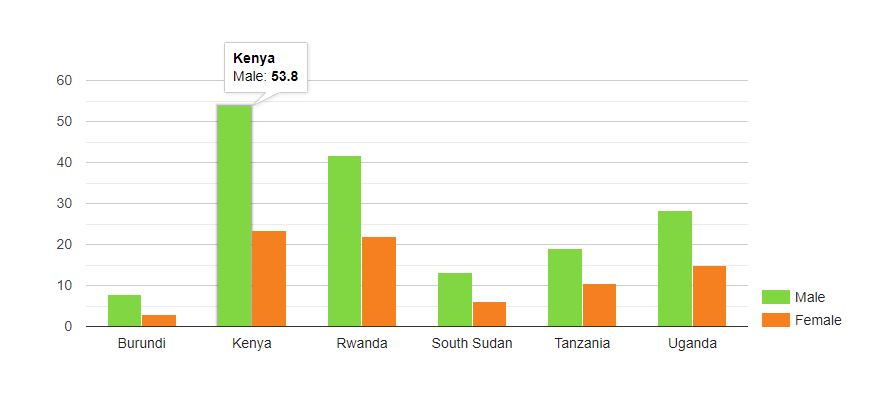Great website! It looks very good! Keep up the great job!
Making truth powerful;
Making power truthful

There exist numerous advocacy campaigns promoting gender equality and fairness to allow women to have equal opportunities in getting wage and salaried jobs. Following the recently celebrated International Women’s Day, we reflect on where the East African region stands with regard to the proportion of women in wage and salaried work, and the opportunities to explore in order to bridge the gap.
Also Read: In East Africa, Women Still Lag Behind in Labor Force Participation
Wage and salaried jobs provide a stable and reliable source of income hence, in most instances, they are dependable for the economic development of individuals and households. In this section, we compare the proportion of women in wage and salaried jobs, compared to women. Similar to the Labor Force Participation Rate, women make up the minority of wage and salaried workers in the region. It is notable that almost across all the countries in East Africa, the % of males in paid employment jobs almost doubles that of females. This is illustrated in the chart below.
There was an issue displaying the chart. Please edit the chart in the admin area for more details.Data Source: World Bank/World Development Indicators
Data released by LinkedIn reveals the fact that, globally, while women stand a higher chance of being employed by up to 16% compared to men, they are 16% less likely to apply for a job they are qualified for, despite them viewing the same number of jobs as men.[1] They are also less likely to ask for a referral for a job compared to men. This one of the factors that help explain the low percentage of women in salaried work. Instability in some countries, weak economies, retrogressive cultures that are pro-patriarchy and general lack of effective and progressive policies that ensure equal representation of women in the workplace are other underlying factors that discourage or hinder women from joining the wage and salaried workforce.
Also Read: More needs to be done to empower women!
To address these disparities, there is a need for further empowerment of females to ensure that they gain access to quality education, which puts them at a better place to compete for opportunities of employment. Additionally, there is a need for corporations and the government to establish policies that ensure women receive equal working opportunities, fair pay and opportunity for career growth, as men.
[1] https://business.linkedin.com/talent-solutions/recruiting-tips/gender-balance-report#

There exist numerous advocacy campaigns promoting gender equality and fairness to allow women to have equal opportunities in getting wage and salaried jobs. Following the recently celebrated International Women’s Day, we reflect on where the East African region stands with regard to the proportion of women in wage and salaried work, and the opportunities to explore in order to bridge the gap.
Also Read: In East Africa, Women Still Lag Behind in Labor Force Participation
Wage and salaried jobs provide a stable and reliable source of income hence, in most instances, they are dependable for the economic development of individuals and households. In this section, we compare the proportion of women in wage and salaried jobs, compared to women. Similar to the Labor Force Participation Rate, women make up the minority of wage and salaried workers in the region. It is notable that almost across all the countries in East Africa, the % of males in paid employment jobs almost doubles that of females. This is illustrated in the chart below.
There was an issue displaying the chart. Please edit the chart in the admin area for more details.Data Source: World Bank/World Development Indicators
Data released by LinkedIn reveals the fact that, globally, while women stand a higher chance of being employed by up to 16% compared to men, they are 16% less likely to apply for a job they are qualified for, despite them viewing the same number of jobs as men.[1] They are also less likely to ask for a referral for a job compared to men. This one of the factors that help explain the low percentage of women in salaried work. Instability in some countries, weak economies, retrogressive cultures that are pro-patriarchy and general lack of effective and progressive policies that ensure equal representation of women in the workplace are other underlying factors that discourage or hinder women from joining the wage and salaried workforce.
Also Read: More needs to be done to empower women!
To address these disparities, there is a need for further empowerment of females to ensure that they gain access to quality education, which puts them at a better place to compete for opportunities of employment. Additionally, there is a need for corporations and the government to establish policies that ensure women receive equal working opportunities, fair pay and opportunity for career growth, as men.
[1] https://business.linkedin.com/talent-solutions/recruiting-tips/gender-balance-report#
Great website! It looks very good! Keep up the great job!

Great website! It looks very good! Keep up the great job!